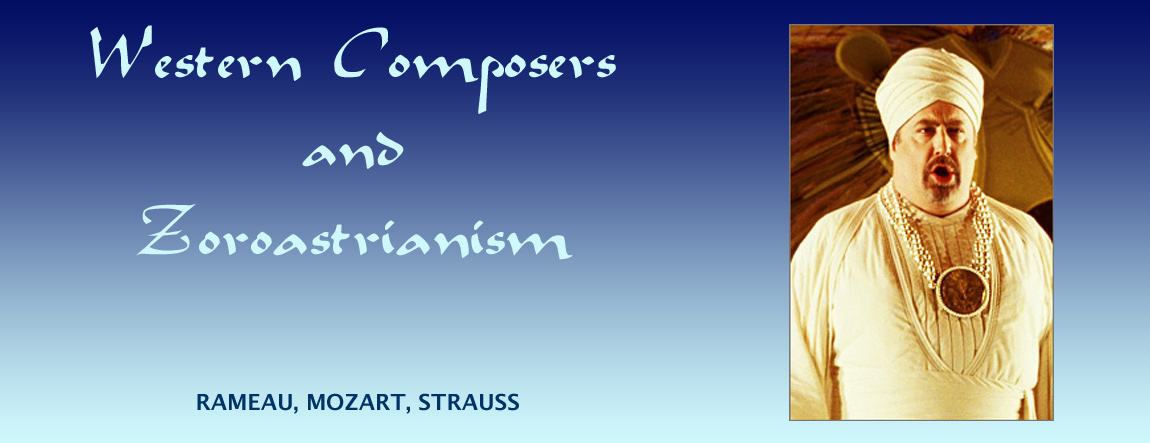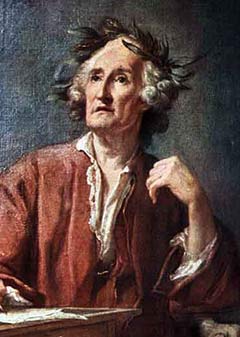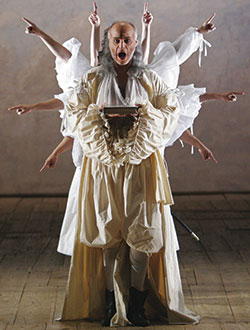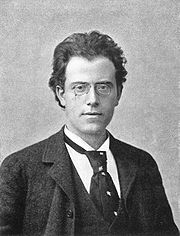
Contents
Western Composers
Jean-Philippe Rameau
Wolfgang Amadeus Mozart
Gustav Mahler
Richard Strauss
Jean-Philippe Rameau
 |
| Jean-Philippe Rameau |
Jean-Philippe Rameau (September 25, 1683 - September 12, 1764 CE) was born in Dijon, France and was one of the most important French composers and music theorists of the Baroque era. Rameau was a secretive man and even his wife knew little about his early life.
Rameau is one of the first modern French composer to break tradition and not write write an opera based on the classical mythology of Greece and Rome. Instead he based his composition on Zoroaster and the principles of Zoroastrianism as it was understood in Europe at that time. He composed the opera Zoroastre (French for Zoroaster and described below) that was first performed on December 5, 1749. The libretto (the text of the opera) was written by Louis de Cahusac. Since Anquetil du Perron, the French scholar who visited India and brought back books of the Avesta did not return to France until 1762, we must look elsewhere for he source of his motivation and information.
We are told that Cahusac, the librettist for Zoroastre, was a leading French Mason and many of his works celebrate the ideals of the European movement, Enlightenment, in which reason was advocated as the primary source and legitimacy for authority. The historical Zoroaster and the themes of the battle between good and evil symbolized by light and darkness were themes highly regarded in Masonic circles. The Masons were also involved in an ideological battle with the Catholic Church, and we also know that Rameau collaborated with Voltaire - a well-known critic of the Church. (Zoroastre ia said to have inspired Mozart to compose The Magic Flute in 1791, another reputed allegory for Masonic ideals.) We wonder, however, if Cahusac, Rameau and Mozart were not directly inspired by Zoroaster and his philosophy.
Rameau's Opera Zoroastre
 |
| Scene from Zoroastre |
The setting for opera Zoroastre, which was first performed on December 5, 1749 at the Opera in Paris, is the ancient kingdom of Bactria, and it story is about the struggle between the forces of Good and Evil. The Good are led by Zoroastre (Zarathustra), a devotee of Oromasès (Ahura Mazda, God) and founder of the magi. The evil are led by the sorcerer Abramane, high priest of Arimane (Ahriman, the Spirit of Evil and whose subterranean voice booms forth at a crisis-point).
The opera swings between the themes of Love and Enlightenment. In Act 1, The opera opens with Bactria in chaos after the death of the king. The King had two daughters, Amélite, the rightful heir to the throne, and the evil Erinice. They are both in love with Zoroastre, who loves Amélite. The sorcerer Abramane plots and succeeds to seize the throne with Erinice who seeks revenge on Zoroastre for rejecting her love. Through Erinice, Abramane has Zoroastre sent into exile. Abramane also conjures up demons to capture Amélite.
In Act 2, the exiled Zoroastre arrives at the palace of the good king, Oromasès. Oromasès tells Zoroastre to go and rescue Amélite and destroy the forces of evil. He puts Zoroastre through a magic initiation ritual to prepare him for the task and enable Zoroastre to summons the spiritual forces of Good. Back in Bactria, deep in the dungeons of the fortress, Abramane and Erinice are torturing Amélite in order to force the rightful heir to renounce the throne, when Zoroastre suddenly appears. He overcomes the usurpers , frees Amélite, and destroys the fortress with his newly acquired powers. Amélite is hailed as queen by her joyful subjects.
In Act 3, One night, after Abramane and Erinice quarrel between themselves over the defeat of their plans, they develop yet another plan to seize the throne of Bactria. At dawn, when Zoroastre, Amélite and the Bactrian people assemble to offer prayers to Ahura Mazda in preparation of the marriage between Zoroastre and Amélite. As the wedding ceremony commences, Abramane who has hidden Erinice in a cloud, arrives on a fiery chariot and kidnaps Amélite. Zoroastre prepares his spiritual forces for war.
In this Act, Rameau's descriptions of elevated spiritual states, symbolized by light, are astonishing - as demonstrated by "O lumiere vive et pure," sung by Zoroastre and the chorus.
In Act 4, As the battle between the spirits of Good and Evil is being waged, Abramane, who is awaiting the outcome in the temple of the Evil Spirit Arimane, receives news that the battle is going badly for him. Through a sacrifice to Arimane, he summons up the demons of Hate, Vengeance and Despair.
In Act 5, Erinice, now repentant, reveals Abramane's plans to Zoroastre. Abramane appears once more in the fiery chariot, reveals Amélite in chains, and threatens mortal harm to her unless Zoroastre surrenders. In response, Zoroastre calls on the spirits of Good who strike down Abramane and his evil priests with thunderbolts. The opera ends with the triumph of the forces of Good over Evil, and rejoicing as Zoroastre and Amélite are crowned king and queen of Bactria.
Jean-Philippe Rameau's Zoroastre - Video Clip
| Opus Arte from Jean-Philippe Rameau's Zoroastre. Recorded live at Drottningholms Slottsteater on the Drottningholm Island, Stockholm, July 2006. |
Wolfgang Amadeus Mozart
 |
| Wolfgang Amadeus Mozart |
Wolfgang Amadeus Mozart (January 27, 1756 - December 5, 1791 CE) baptized as Johannes Chrysostomus Wolfgangus Theophilus Mozart, and who wrote over 700 musical compositions, was born in Salzburg, a city now part of Austria. He is reputed to have become proficient with the piano violin, by the age of five when he created his first composition. He performed before European royalty at the age of 17 and from there went on to become one of the best known European composers in history.
In , 1791, Mozart composed an opera called Die Zauberflöte, The Magic Flute. Its libretto, the text or words, were written by Emanuel Schikaneder. Like, Rameau's Zoroastre, the Magic Flute draws on Zoroastrian themes, though somewhat less directly than Zoroastre.
Brigid Brophy in her biography, Mozart The Dramatist (New York: Da Capo Press, 1988, p.187), wonders if Mozart and his librettists may have acquired their knowledge of Zoroaster from Lucian, the Voltaire of the ancient world, who took the Cynic Menippos as a hero of his romance. "Menippos says that when he had made up his mind to visit the Underworld he decided 'to go to Babylon and ask a favour of one of the Magi, the disciples and successors of Zoroaster (tinoõ twn magwn twn Zwroastrou maqhtwn kai diadocwn).'"
However, Mozart in all likelihood also had access to the Zoroastrian scriptures, the Avesta . While Rameau had composed his opera before Anquetil du Perron's return to France in 1762 with copies of the Avesta that he translated into French, Mozart composed his opera after that time. Mozart also had access to a German translation (of du Perron's French version) by Johann Friedrich Kleuker (1749 -1827), Professor of Theology in the University of Riga. Kleuker published his German translation in Leipzig and Riga between 1776 and 1777.
There is another link between du Perron and Mozart's Magic Flute. In a memoir on Plutarch, Anquetil had tried to show that the account of the Magian religion in the Avesta fully agreed with the account of the Egyptian myth of Isis and Osiris. (And it around the myth of Isis and Osiris that Mozart composes his opera. Isis and Osiris also appear in the symbolism of Freemasonry.) Kleuker enlarged the circle of comparison to the whole of ancient literature.
One modern biographer of Mozart, Maynard Solomon in his Mozart, A Life (New York: Harper Perennial, 1996, p.344), thinks that "Mozart's attraction to a Zoroastrian orientalism is in the tradition of the Masonic lodges and reading societies, which were hotbeds of interest in the exotic, the oriental, and the miraculous." Brophy, who we had cited a couple of paragraphs above, proposes that "Masonry's central allegory, the triumph of light over dark, is shared with the very metaphor of the Enlightenment, with everyday speech (which says 'I see' in the sense of 'I understand'), and with the cult of Osiris (the sun) and Isis (the moon, which can illuminate even the night).
Mozart's Magic Flute / Die Zauberflöte
The setting of Mozart's opera, the Magic Flute, is Temple of Isis in Memphis, Egypt (about the reign of Ramses I).
The opera's characters Tamino, an Egyptian Prince, and Pamina, daughter of the Queen of the Night, undergo an ordeal to prove that they are worthy of the higher happiness and willing to fight for the love of wisdom. This initiation ceremony for admission to the Temple of Sun and its Light includes passing through an ordeal of fire and water. The high priest of the temple at Isis is Sorastro, a name that appears to have been derived from Zoroastre (Zoroaster) and who possesses the Seven-fold Sun Circle. Once Tamino and Pamina have gained access to the light, the Queen of the Night and her court, who are the cause of all darkness, wickedness and superstition, are overcome by the light of the Bright Sun. They and darkness are banished into the bowels of the earth and into eternal night. Sorastro proclaims "The rays of the sun expel the night and annihilate the power of the hypocrite!" He grants that all the followers of wisdom, which now includes the triumphant lovers, Tamino and Pamina, " are crowned with everlasting crowns of beauty and wisdom."
Mozart & Zoroastrian Riddles
If Mozart's The Magic Flute indirectly referenced Zoroaster, his riddles were a direct reference to Zoroaster. In a letter to his father, Mozart writes that on February 19, 1786 during the Carnival in Vienna, while dressed and masquerading as Zoroaster, he handed out a sheets of paper on which were written eight riddles and fourteen proverbs titled 'Excerpts from the Fragments of Zoroaster'.
Mozart's father made the riddles and proverbs available to Lorenz Hubner, editor of a Salzburg newspaper who published one riddle and seven of the proverbs in an issue of his newspaper on March 23, 1786. The editor, however, neglected to credit Mozart, and it was not until 1970, that the remaining riddles, written in Mozart's hand were discovered in the Staatbibliothek Preussicher Kulturbesitz at Berlin, Germany. Unfortunately, two of the riddles had been made illegible by Mozart's wife, Cosnstanze Mozart's second husband, George Nissen who had found the riddles and some passages in Mozart's letter objectionable.
Riddling, we are given to understand, was a popular pastime in Europe during Mozart time and in addition to Mozart, other notable riddlers were Goethe, Schiller, Voltaire and Rousseau. Mozart was fascinated by codes, ciphers, puns and even, we are told, scatological language. The text of the two riddles used by Nyman are as follows:
1. "We are many sisters; it is painful for us to unite as well as to separate. We live in a palace, yet we would rather call it a prison, for we are securely locked up and must work for the sustenance of men. The most remarkable thing is that the doors are opened for us quite often, both day and night, and we still do not come out, except when one is pulled out by force."
2. "I am an unusual thing; I have no soul and no body; one cannot see me but can hear me; I do not exist for myself; only a human being can give me life, as often as they he wishes, and my life is only of short duration, for I die almost at the moment in which I am born. And so, in accordance with men's caprice, I may live and die untold times a day. To whose we give life I do nothing - but those on whose account I am born I leave with painful sensations for the short duration of my life until I depart."
The intended solution of the first riddle could be 'teeth'. We do not know the answer to the second riddle.
Mozart's Zoroastrians riddles have inspired the following compositions:
Michael Nyman's (born March 23, 1944 in Stratford, London), one act opera for television titled Letters, Riddles and Writs where the song texts are based on the letters between Mozart and his father as well as the riddles Mozart wrote for the Carnival in 1782.
Richard Danielpour's Concerto for Orchestra (1996) is subtitled 'Zoroastrian Riddles' in recognition of Mozart's dual interest in the popular eighteenth-century pastime of riddling as well as Zoroaster as the emblem of ancient wisdom.
Mozart's Magic Flute / Die Zauberflöte - Video Clip
| Diana Damrau as Queen of the Night in Mozart's Die Zauberflöte (The Magic Flute). The Aria, Der Hölle Rache, starts at 2min.15secs on the video |
Gustav Mahler
 |
| Gustav Mahler |
Gustav Mahler (July 7, 1860 - May 18, 1911 CE) was born in Kalischt, Bohemia, today in the Czech Republic, but which at the time of Mahler's birth was part of the Austrian Empire. Mahler began his career in 1880 as a conductor with a job at a summer theatre at Bad Hall, a small market town in upper Austria. His family were German-speaking, Ashkenazi Jews though Mahler would convert to Roman Catholicism in preparation for accepting the directorship of the Vienna State Opera, the most prestigious musical position in the Austrian Empire, and one which as Imperial post, could not be occupied by a Jew under Austro-Hungarian law. Despite his conversion, later in his career he would fall victim to increasing anti-Semitism. After attacks in anti-Semitic sections of the press, he resigned his position at the Vienna State Opera in 1907. Mahler's estranged wife Alma Mahler quoted her husband as saying "I am thrice homeless, as a native of Bohemia in Austria, as an Austrian among Germans, and as a Jew throughout the world. Everywhere an intruder, never welcomed."
Mahler's departure from Vienna was also aided by a generous offer to conduct the Metropolitan Opera in New York in 1908. Though he was acclaimed by his audiences and music critics, he had a falling out with the trustees of the board of the Met who after a year terminated Mahler's employment in favour of Arturo Toscanini. Mahler returned to Europe under great emotional stress. In addition to his loss of employment, his health and marriage were failing. In 1910, Mahler had a consultation with Sigmund Freud.
Mahler returned to the United States in 1910 with a contract to conduct the New York Philharmonic Orchestra. In February 1911, he conducted a concert with a fever from a streptococcal blood infection. The concert would be his last. After he brief stay for treatment in Paris, Mahler returned to Vienna where he passed away on May 18, 1911. Mahler's good friend Bruno Walter described the funeral with the word, "On 18 May 1911, he died. Next evening we laid the coffin in the cemetery at Grinzing, a storm broke and such torrents of rain fell that it was almost impossible to proceed. An immense crowd, dead silent, followed the hearse. At the moment when the coffin was lowered, the sun broke through the clouds." At his request, Mahler was buried in silence and his gravestone bore only his name 'Gustav Mahler'.
While Mahler had achieved fame and recognition as a leading orchestral and operatic conductor, his music compositions, primarily symphonies and songs, only achieved acceptance after his death. He had died at the age of 50, leaving his tenth Symphony unfinished. He is generally recognized as the last great German symphonist.
Mahler's 3rd Symphony
 |
| The Komponierhäuschen (Composer's cottage) in Steinbach am Attersee, where Mahler composed his Third Symphony |
Gustav Mahler used Nietzsche's roundelay (a poem in Chapter 59, The Second Dance-Song) as the text for the 4th movement (originally titled What Man Tells Me) of the 3rd Symphony, which he composed in between 1893 and 1896, during his tenure as director of the Hamburg Opera. It is his longest symphony in the standard repertoire, with a typical performance lasting around ninety to one hundred minutes. From 1893 to 1896, Mahler spent his summer vacations at Steinbach am Attersee in Upper Austria. He spent most of his vacation time composing his first three symphonies.
The 3rd Symphony is a hymn to Nature, and its successive movements envisage the world at the arrival of spring - the wild flowers, the animals in the wood, the life of man, the realm of the angels and the realm of love and God. He gave each of the six movements a name, names dropped before publication of the symphony in 1898. The names were:
1. Pan Awakes, Summer Marches In
2. What the Flowers on the Meadow Tell Me
3. What the Animals in the Forest Tell Me
4. What Man Tells Me (setting of Friedrich Nietzsche's roundelay or "Midnight Song")
5. What the Angels Tell Me
6. What Love Tells Me
Mahler describes the symphony's last movement alternatively as as "What love tells me" and, "What God tells me". This artistic vision moves from a veneration of divinity within nature to a search for divinity that transcended physical existence. With this evolution in his understanding of the nature of God, Mahler by identifying nature with divinity on the one hand, and then on the other conceiving God's essence as transcending existence, gave humankind room to celebrate divinity within nature without becoming idolatrous.
Later composers influenced by Mahler included Schoenberg, Shostakovich and Richard Strauss.
Mahler's 3rd Symphony, 4th Movement - Video Clip
| Gustav Mahler: Symphony No. 3 (4th Movement. Nachtwandlerlied/Midnight Song. Sehr langsam. Misterioso) Claudio Abbado (Conductor), Anna Larsson (Soloist) at the Lucerne Festival 2007 |
Richard Strauss
 |
| Richard Georg Strauss |
Richard Georg Strauss (June 11, 1864 – September 8, 1949 CE) was born in Munich, Germany, and like Mozart is credited with writing his first musical composition music at the age of six, and continued to write music almost until his death.
In November 1933, the Nazi Reich Minister of Public Enlightenment and Propaganda, Joseph Goebbels appointed Strauss to the post of president of the Reichsmusikkammer, the State Music Bureau, an appointment that stigmatized Strauss who nevertheless decided to remain apolitical. While in this position he composed the hymn for the 1936 Summer Olympics that were to be held in Berlin. However, by the time the games were held he had lost the position the Nazis had given him. Strauss was forced to resign his position as president of the State Music Bureau after refusing to remove from Die schweigsame Frau's playbill, the name of its Jewish librettist, his friend and colleague Stefan Zweig. When Zweig was being harassed by the Nazis, Strauss sent him a letter of support in which Strauss insulted the Nazis. The letter was intercepted by the Gestapo.
The Nazis wanted to introductory fanfare to Also sprach Zarathustra as a new national anthem for Germany. Strauss declined the request.
Also Sprach Zarathustra
Strauss composed Also sprach Zarathustra in 1896, a composition classed as a symphonic or tone poem (a composition consisting of a single continuous section or movement in which the content of a poem, story, novel, painting, landscape or other source is given a musical interpretation). In this case, the musical poem was based on Nietzsche's book by the same name and published in published 1885. While Strauss' composition has been part of the classical repertoire since its introduction, the fanfare is recognized as the opening theme for the 1968 film, 2001: A Space Odyssey, as the introduction to every show performed by Elvis Presley from 1969 onwards, and from the music played by bands at athletic events.
Strauss' Also Sprach Zarathustra - Video Clip
| Zubin Mehta conducts Sächsische Staatskapelle Dresden Symphony Orchestra playing Richard Strauss' Also Sprach Zarathustra Op. 30. Part 1 |
| Zubin Mehta conducts Sächsische Staatskapelle Dresden Symphony Orchestra playing Richard Strauss' Also Sprach Zarathustra Op. 30. Part 2 |
| Zubin Mehta conducts Sächsische Staatskapelle Dresden Symphony Orchestra playing Richard Strauss' Also Sprach Zarathustra Op. 30. Part 3 |
| Richard Strauss: Also Sprach Zarathustra excerpts. Estonian National Symphony Orchestra led by Milen Nachev |